
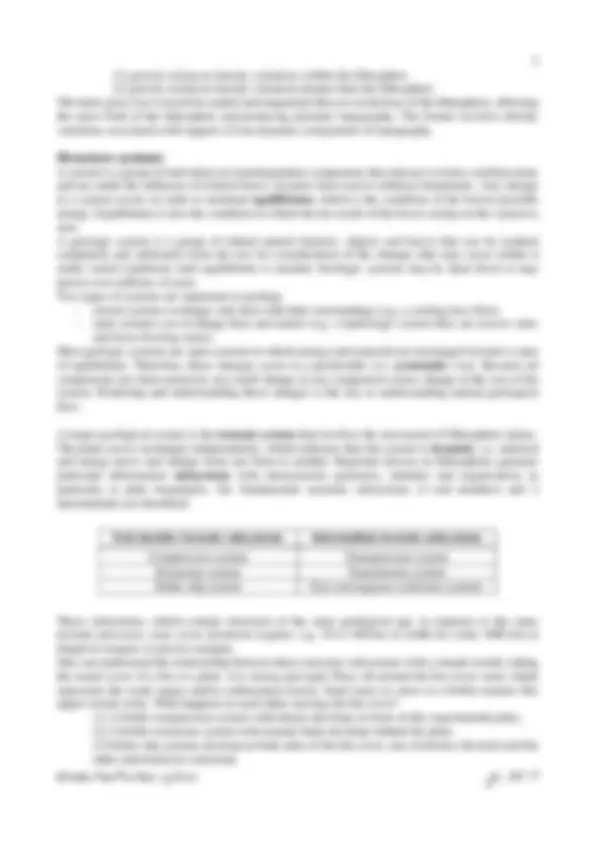
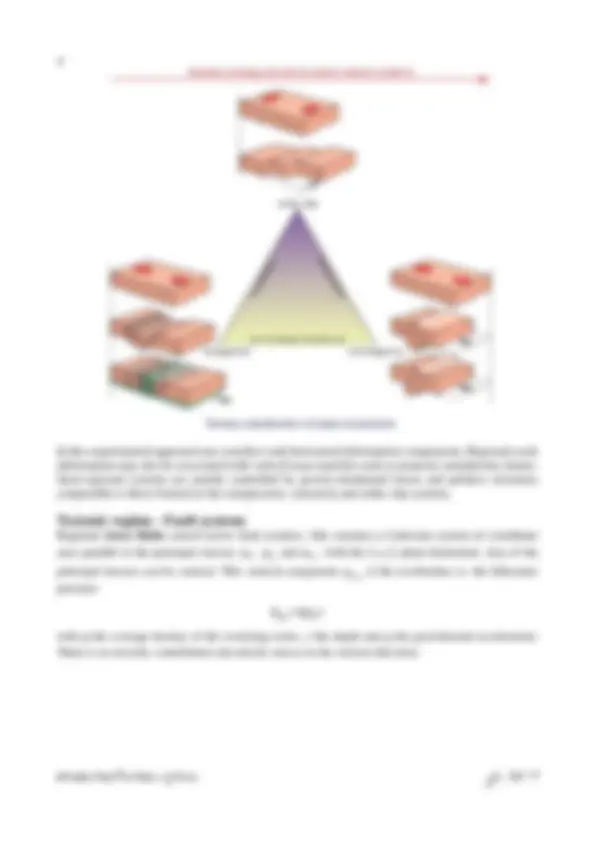
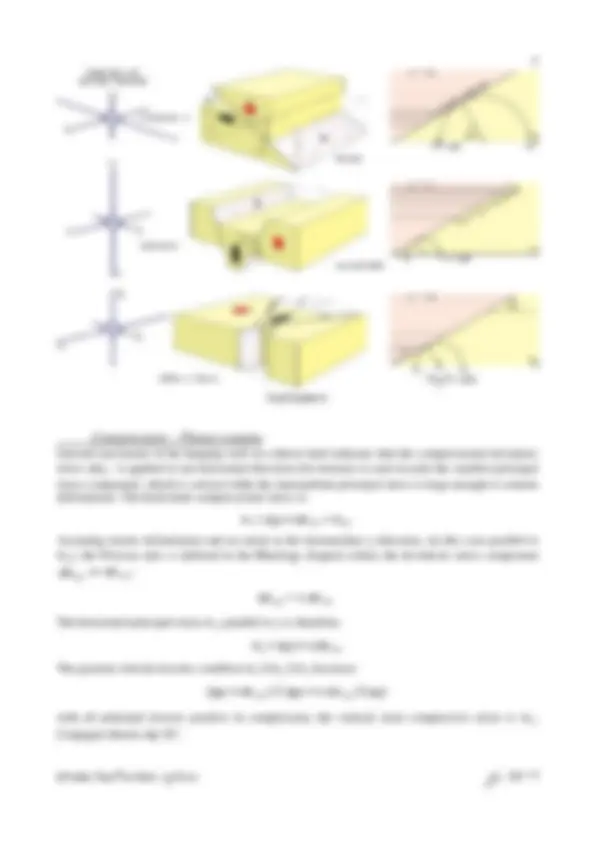
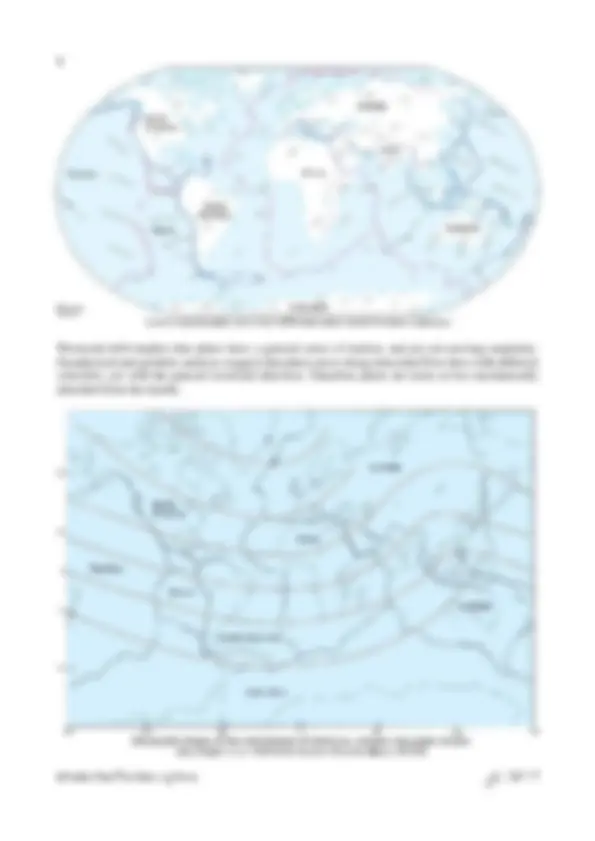
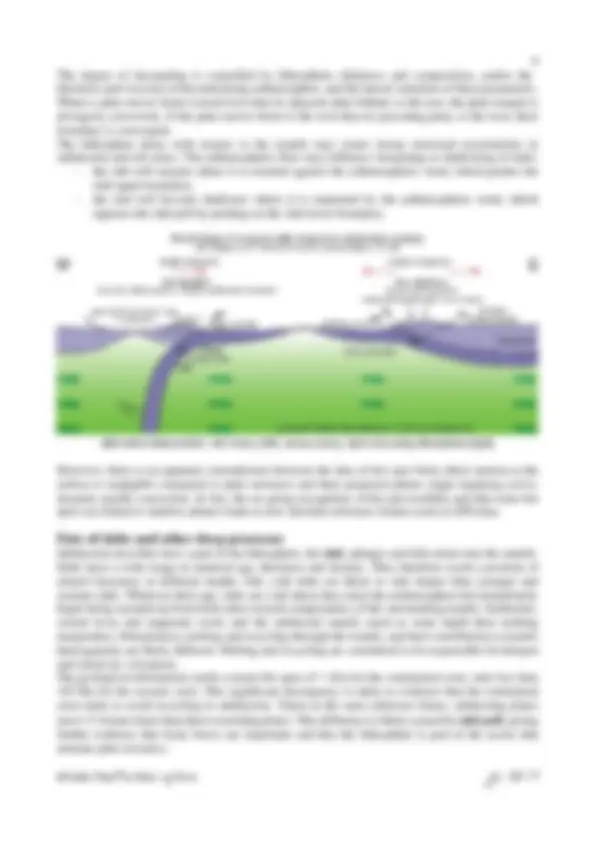
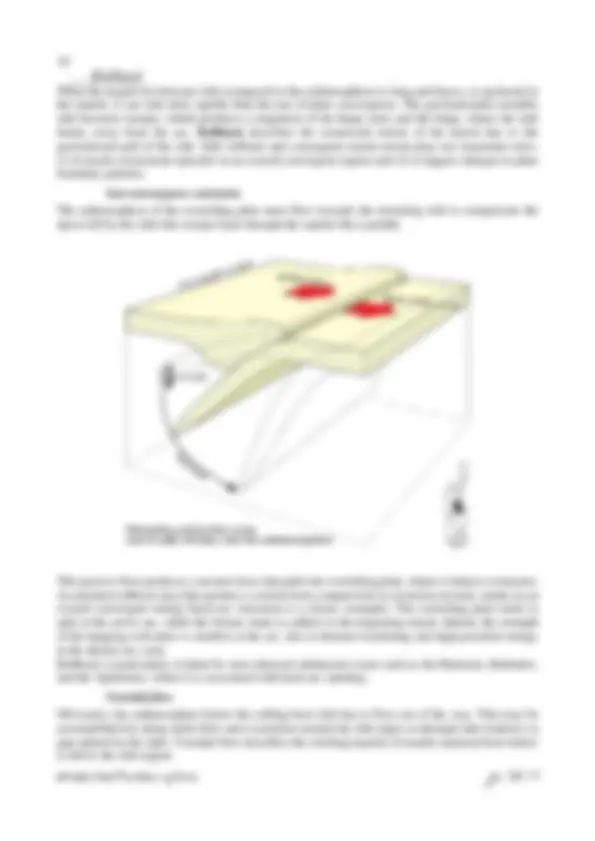
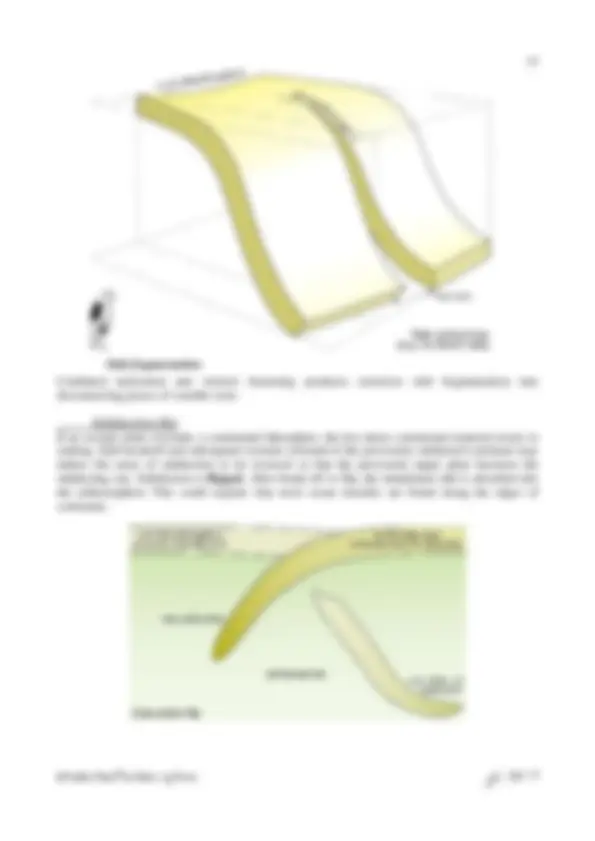
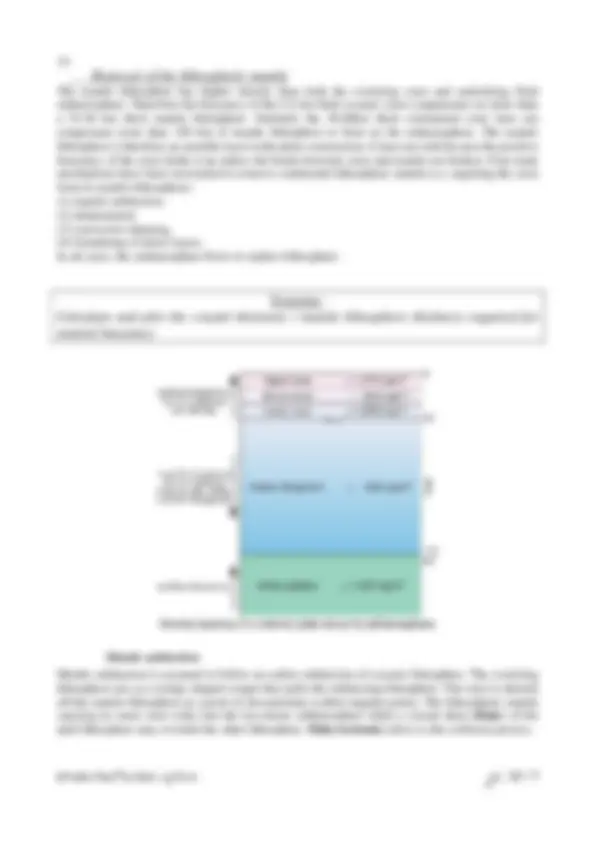
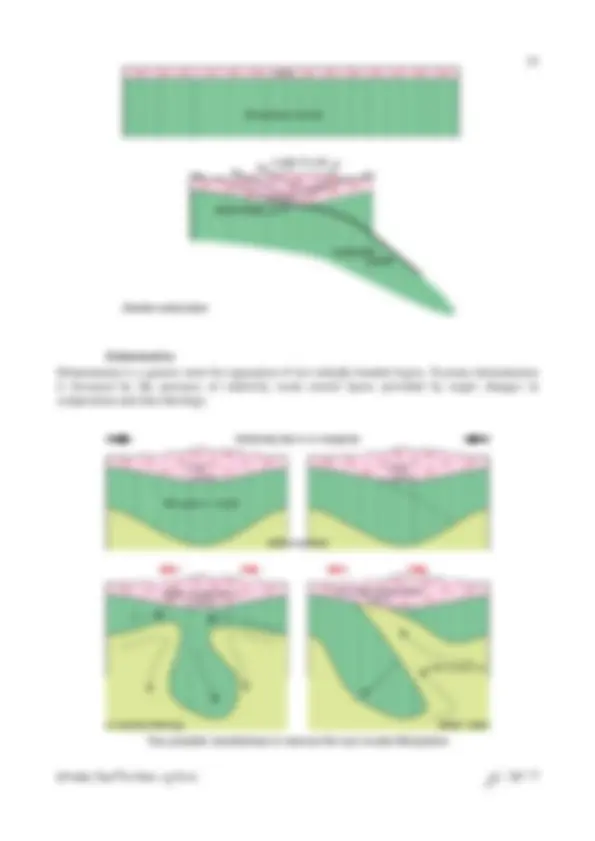
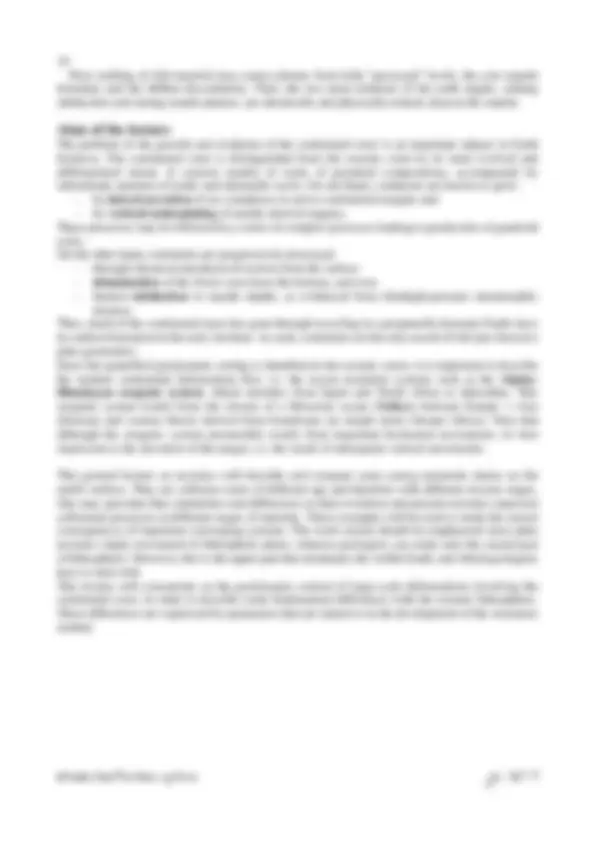
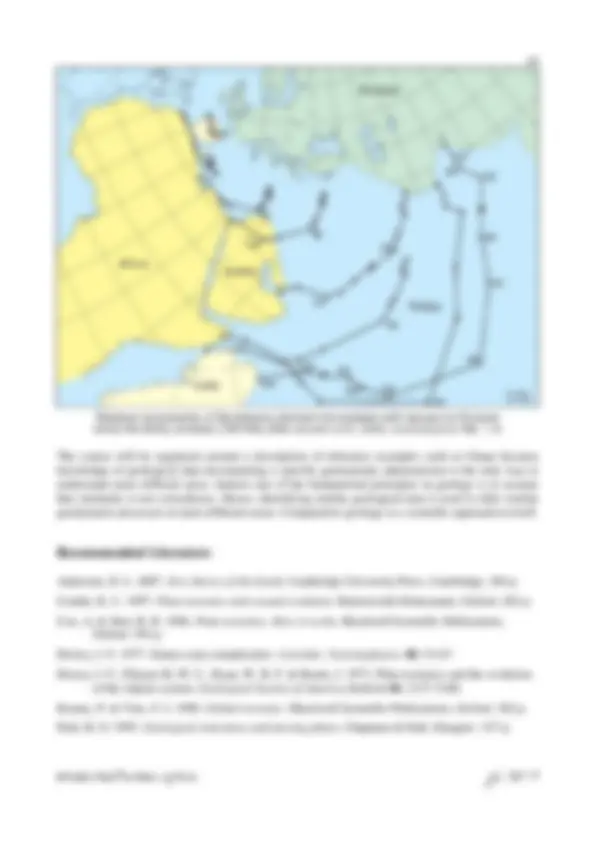



Study with the several resources on Docsity

Earn points by helping other students or get them with a premium plan


Prepare for your exams
Study with the several resources on Docsity

Earn points to download
Earn points by helping other students or get them with a premium plan
Community
Ask the community for help and clear up your study doubts
Discover the best universities in your country according to Docsity users
Free resources
Download our free guides on studying techniques, anxiety management strategies, and thesis advice from Docsity tutors
An introduction to plate tectonics, a geological process that explains the movements and consequences of the Earth's lithospheric plates. the composition of the Earth, the concept of plate motions, the role of thermally-driven mass movements, and the different types of plate boundaries. It also discusses the importance of plate tectonics in understanding Earth's evolution and the relationship between plates and the underlying mantle.
Typology: Study notes
1 / 20

This page cannot be seen from the preview
Don't miss anything!













The Earth is composed of layers of different composition and physical properties, principally the solid central core, the fluid peripheral core, the viscous mantle, and the solid lithosphere. The lithosphere is comprised of the upper mantle and the crust, the outer shell of the Earth. There are two types of lithosphere, according to the crust resting on the solid mantle lithosphere ( lithospheric mantle ): the oceanic lithosphere has a 5 to 8km thick oceanic crust (with a basaltic composition) and the continental lithosphere has a 30km to 40km thick granitic-dioritic crust. The lithosphere is fragmented into pieces of variable shape and size, the plates. The edges of the plates are called plate boundaries. The Earth has 7 major plates (Africa, Antarctica, Australia, Eurasia, North America, South America and Pacifica) and several minor ones (Adria, Arabia, Caribbean, Nazca, Philippines and others). Most of the plates are composed of continental and oceanic lithosphere. These plates move independently relative to one another, with a restricted independence from the 7 large plates, however. The relative, horizontal movements are ideally described as rigid body motions that produce space and friction problems at the contacts between adjacent plates. Plate boundaries are not fixed; they also move and change shape. The global mosaic of plates periodically reorganizes itself and new plate boundaries form while others close up. Plate tectonics , the study of such relative motions and their consequences, allows relating surface, geological and geophysical structures with quantified movements attributed to deep processes of the Earth’s heat engine: The interior is hot, space is cold; the second law of thermodynamics states that this gradient will drive spontaneous convection processes in pursuit of equilibrium. The motion of lithospheric plates is a considerable consequence of thermally-driven mass movements on the Earth.
The Earth is the only planet known to currently have plate tectonics. This suggests that Earth possesses a unique combination of heat budget (probably a matter of size; compare with Mars, about half size of the Earth) and rheology: the surface is rigid enough to make plates (compare with Jupiter
made up almost entirely of gases) but weak enough to localize strain (compare with Venus, similar size and composition as Earth, but possibly stronger lithosphere). Geodynamics is the discipline of Earth Sciences that attempts to explain observations about the recent large-scale features of the globe in terms of mechanical (dynamic) principles. It becomes accepted that repeated amalgamation and subsequent breakup of continental lithosphere along with repeated creation and subduction of oceanic lithosphere have profoundly affected Earth’s evolution since the Archaean. In this plate-tectonic framework, large-scale deformation is the local response of the lithosphere to induced stresses.
The large-scale features of the Earth are geographic (map distribution and topography) and result from both horizontal movements that may reach up to >20 cm/year and vertical components of up to 10 mm/year. This is an order of magnitude difference. This is why also, on a structural / geodynamic point of view, the horizontal, relative movements between plates (as fast as nails grow!) will dominate the structures of interest to geologists, keeping in mind that at some stage (an order of magnitude less) vertical movements will also have to be taken into consideration. Plates may:
On the present earth, the plate organization has formed two networks: (1) an about 70000 km long chain of divergent boundaries and (2) an about as long chain of convergent boundaries. Both are segmented and connected by strike slip boundaries. This simple organization results from the patterns of plate motions and mantle convection, which are stable on a long term. In fact, the stresses that drive lithospheric motion arise from two sources:
In this experimental approach one considers only horizontal deformation components. Regional-scale deformation may also be associated with vertical mass transfers such as anatectic and plutonic domes. Such regional systems are usually controlled by gravity-dominated forces and produce structures comparable to those formed in the compression, extension and strike-slip systems.
Regional stress fields control active fault systems. One assumes a Cartesian system of coordinate
axes parallel to the principal stresses (^) σ 1 , (^) σ 2 and (^) σ 3 , with the (^) ( x, y) plane horizontal. Any of the
principal stresses can be vertical. This vertical component σzz is the overburden i.e. the lithostatic
pressure:
There is no tectonic contribution (deviatoric stress) in the vertical direction.
Upward movement of the hanging wall on a thrust fault indicates that the compressional deviatoric stress ∆σii is applied in one horizontal direction (for instance x) and exceeds the smallest principal
stress component, which is vertical while the intermediate principal stress is large enough to contain deformation. The horizontal compressional stress is:
σ 1 = ρgz + ∆σ (^) xx = σxx
Assuming elastic deformation and no strain in the intermediate y-direction, (in this case parallel to σ 2 ), the Poisson ratio ν (defined in the Rheology chapter) relates the deviatoric stress component ∆σ yy to^ ∆σxx^ :
∆σ (^) yy = ν ∆σ. xx
The horizontal principal stress σ 2 parallel to y is therefore:
The general, triaxial tectonic condition σ 1 ≥ σ 2 ≥ σ 3 becomes:
( ρgz^ + ∆σxx^ ) ≥ ρ( gz^ + ν ∆σ.^ xx)≥ ρgz
Conjugate thrusts dip 30°.
disintegration) of radioactive elements in mantle rocks lead to theoretical estimates of enough energy to generate whole mantle convection.
Seismic tomographic images and progress in numerical modelling suggest that three modes of flow dominate the structure of the Earth's mantle: (1) Subducting plates, some of which penetrating into the deeper lower mantle (e.g. Circum-Pacific region), attest for descending currents; (2) Large-scale, broad upwelling-plumes like beneath mid oceanic ridges (e.g. South Pacific), attesting for ascending currents; (3) Small-scale upwelling-plumes. Continents move, ridges and subduction zones move or disappear. Therefore, the distribution of convection cells varies with time, which implies that mantle convection is not-stationary.
Hot spots are stationary, intraplate and long-lived volcanic centres whose origins were speculated to be in particularly hot source regions, deep in the mantle. Their surface traces are long, narrow, time- progressive volcanic chains used to infer that the lithosphere is moving on top of such spatially restricted and supposedly fixed sources, which deliver magma through rising plumes. Plumes are considered to be heat- and melt-transporting columnar diapirs rising from the core–mantle boundary because of their thermal buoyancy. Hot spots are independent of, and usually remote from plate boundaries. However they are an important element of mantle convection. About 10% of heat flow across the mantle is apparently carried by plumes, which are driven by basal heating rather than surface cooling and subduction of cold lithosphere. The related, volcanic centers have huge lava production rates and provide a reference point for anchoring measurements of plate kinematics, provided the hotspots are maintained over sufficiently long times. If hot spots are relatively fixed and nearly punctual surface terminations of narrow plumes, then they constitute a framework for calculation of absolute plate motions. On the basis of such a hot-spot reference frame , an average >50 mm.a–1 westward drift of the lithosphere relative to the asthenospheric mantle has been assessed. This drift is an average delay of the lithosphere with respect to the hot spots but, conversely, is also a relative eastward flow of the asthenosphere with respect to the lithosphere. The Earth’s rotation may contribute to this bulk flow (the asthenospheric “wind”) and mantle dynamics.
Westward drift implies that plates have a general sense of motion, and are not moving randomly. Geophysical and geodetic analyses suggest that plates move along sinusoidal flow lines with different velocities, yet with the general westward direction. Therefore plates are more or less mechanically detached from the mantle.
When the negatively buoyant slab (compared to the asthenosphere) is long and heavy, or anchored in the mantle, it can sink more rapidly than the rate of plate convergence. The gravitationally unstable slab becomes steeper, which produces a migration of the hinge zone and the bulge, where the slab bends, away from the arc. Rollback describes the oceanward retreat of the trench due to the gravitational pull of the slab. Slab rollback and consequent trench retreat play two important roles: (1) It inserts extensional episodes in an overall convergent regime and (2) it triggers changes in plate boundary patterns.
Syn-convergence extension
The asthenosphere of the overriding plate must flow towards the retreating slab to compensate the space left by the slab that sweeps back through the mantle like a paddle.
This passive flow produces a suction force that pulls the overriding plate, where it induces extension. Accelerated rollback may thus produce a switch from compression to extension tectonic modes in an overall convergent setting (back-arc extension is a classic example). The overriding plate tends to split at the active arc, while the forearc tends to adhere to the migrating trench. Indeed, the strength of the hanging wall plate is smallest at the arc, due to thermal weakening and high potential energy in the thicker arc crust. Rollback is particularly evident for west-directed subduction zones such as the Marianas, Barbados, and the Apennines, where it is associated with back-arc opening.
Toroidal flow
Obviously, the asthenosphere below the rolling-back slab has to flow out of the way. This may be accomplished by along strike flow and evacuation around the slab edges or through slab windows (a gap opened in the slab). Toroidal flow describes the swirling transfer of mantle material from below to above the slab region.
Realignment of plate boundaries
Rollback is essential in changing the orientation of plate boundaries. Paleomagnetic measurements on the Fiji Islands show that the latter have rotated by 90° over the last 40 Ma, which implies that the trench line near the Tonga-Kermadec arc has pivoted by about the same angle about the North Island of New-Zealand. Such rotations suggest that rollback is effective between a rotation axis and a tear fault in the slab. The process might be able to generate curved orogens.
Slab fragmentation
Combined horizontal and vertical fracturing produces extensive slab fragmentation into disconnecting pieces of variable sizes.
If an oceanic plate overrides a continental lithosphere, the less dense continental material resists to sinking. Slab breakoff and subsequent isostatic rebound of the previously subducted continent may induce the sense of subduction to be reversed so that the previously upper plate becomes the subducting one. Subduction is flipped. After break-off or flip, the abandoned slab is absorbed into the asthenosphere. This could explain why most ocean trenches are found along the edges of continents.
The mantle lithosphere has higher density than both the overlying crust and underlying fluid asthenosphere. Therefore the buoyancy of the 5-8 km thick oceanic crust compensates no more than a 35-56 km thick mantle lithosphere. Similarly the 30-40km thick continental crust does not compensate more than 250 km of mantle lithosphere to float on the asthenosphere. The mantle lithosphere is therefore an unstable layer in the plate construction. It does not sink because the positive buoyancy of the crust holds it up unless the bonds between crust and mantle are broken. Four main mechanisms have been envisioned to remove continental lithospheric mantle (i.e. ungluing the crust from its mantle lithosphere): (1) mantle subduction, (2) delamination (3) convective thinning, (4) foundering of dense layers. In all cases, the asthenosphere flows to replace lithosphere.
Mantle subduction
Mantle subduction is assumed to follow an earlier subduction of oceanic lithosphere. The overlying lithosphere acts as a wedge-shaped scraper that splits the subducting lithosphere. The crust is sheared off the mantle lithosphere at a point of discontinuity (called singular point). The lithospheric mantle carrying no more crust sinks into the less-dense asthenosphere while a crustal sheet ( flake ) of the split lithosphere may override the other lithosphere. Flake tectonics refers to this collision process.
Earth scientists have envisioned two possibilities: layer division and convective thinning. In both cases, the asthenosphere flows to replace the lithosphere. Subsequent heating may cause partial melting and magma generation. Magma may intrude the upper crust as post-orogenic plutons. In addition, the hot asthenosphere replacing the heaviest lithosphere triggers isostatic uplift. Geographical and time propagation of magmatism and uplift might help differentiating these delamination modes.
Layer separation
Dense crustal and/or mantle layers are ripped away from the layers atop. The negatively buoyant, detached layers or portions of dense layers sink into the deeper mantle and asthenosphere. While mantle lithosphere progressively peels away from crust as a coherent sheet, the delamination point migrates away from its starting point and the region of thinned lithosphere enlarges. Hot asthenosphere invades the gap as it opens between the descending mantle and the crust.
Convective thinning
Lithospheric shortening in orogenic belts is isostatically accommodated by the formation of a thick lithospheric root. Convective thinning is then driven by the negative buoyancy of the mantle lithosphere thickened by shortening. The mantle lithosphere from adjoining regions flows into the downwelling as this Rayleigh-Taylor instability grows. Eventually, upwelling asthenosphere replaces the mantle lithosphere as it is thinned and stretched. The downwelling lithosphere drops into the asthenosphere, which substantially increases the gravitational potential energy of the overlying continental crust. Conductive warming reduces the strength of the orogen. As a result the orogen may be thrown into extension, as the isostatically uplifted crust attempts to spread laterally (post- collisional collapse of orogens).
Thermal erosion
The boundary between lithosphere and asthenosphere is thermally controlled, since it is the same material (peridotite) in solid and liquid forms. Convective thinning occurs as heat is advected to the base of the lithosphere at a rate larger than normal basal flux, and conducted within the lithosphere. Convection in the liquid asthenosphere is a process of heat transfer much more efficient than conduction in the solid shell. In that case, temperature is increased and the melting point can be exceeded at the bottom of the mantle lithosphere. Then the mantle lithosphere thins down as it is transformed into asthenosphere.
The heat excess can be carried to the lithosphere by mantle plumes that cause the lithosphere to thin with isotherms progressively rising through. Uplift in large swells is due to thermal expansion more than dynamic overpressure of the impinging plume. Delamination could start once the asthenosphere has cut the mantle lithosphere and reached the crust.
Foundering of dense layers
Dense mafic/ultramafic layers of the crust and portions of mantle lithosphere fall down as viscous chunks into the less dense asthenosphere. The upwelling asthenosphere replaces the removed lithospheric pieces but the region of thinned lithosphere keeps the same size and areal limits as at the division time.
Seismic observations show a shear velocity discontinuity and a density jump at 660 km depth and several slow anomalies just underneath. This seismic discontinuity is the boundary between the upper and the lower mantle and is attributed to a phase change from spinel at low pressure to much stiffer perovskite at higher pressure. Earthquakes occur all the way down to this boundary, but not below. The seismic tomography supportively images lithospheric slabs subducting through the upper mantle. They are either deflected along the upper-mantle/lower-mantle transition zone and/or penetrate into the lower-mantle down to the core-mantle boundary. Tomographic results suggest piling of gigantic recumbent folds laying at this boundary, similar to buckles of honey poured on a slice of bread (e.g. beneath the Caribbean). Laying ( stagnant ) slabs and buckle folds both indicate that subducted lithosphere experiences resistance to further penetration when they encounter the 660 km deep discontinuity.
The lowermost lower mantle, known as the D”-layer (depth between ca 2700 and 2900 km), has been postulated to be the ultimate destination of slabs. This layer may reflect a change in mineral structure from the relatively low-temperature magnesium silicate perovskite to a post-perovskite form at the core-mantle boundary. High seismic velocities and reflections from just above the anomalously high wave speed core image relatively cold slab material laying and accumulated on the core-mantle boundary but the evidence is disputed.
The course will be organised around a description of reference examples such as Oman because knowledge of geological data documenting a specific geodynamic phenomenon is the only way to understand more difficult areas. Indeed, one of the fundamental principles in geology is to assume that similarity is not coincidence. Hence, identifying similar geological data is used to infer similar geodynamic processes in more different areas. Comparative geology is a scientific approach in itself.
Anderson, D. L. 2007. New theory of the Earth. Cambridge University Press, Cambridge. 384 p.
Condie, K. C. 1997. Plate tectonics and crustal evolution. Butterworth-Heinemann, Oxford. 282 p.
Cox, A. & Hart, R. B. 1986. Plate tectonics. How it works. Blackwell Scientific Publications, Oxford. 392 p.
Dewey, J. F. 1977. Suture zone complexities: A review. Tectonophysics 40 , 53-67.
Dewey, J. F., Pitman III, W. C., Ryan, W. B. F. & Bonin, J. 1973. Plate tectonics and the evolution of the Alpine system. Geological Society of America Bulletin 84 , 3137-3180.
Kearey, P. & Vine, F. J. 1990. Global tectonics. Blackwell Scientific Publications, Oxford. 302 p.
Park, R. G. 1993. Geological structures and moving plates. Chapman & Hall, Glasgow. 337 p.
Turcotte, D. L. & Schubert, G. 2002. Geodynamics. Cambridge University Press, Cambridge. 456 p.
Windley, B. F. 1995. The evolving continents. John Wiley & Sons Ltd, Chichester. 526 p.